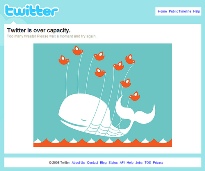I wrote a post for Jeff Lash over at Ask A Good Product Manager in response to a question he received from one of his MANY readers. The question was:
How can I determine the need and saleability of a “new to the world” product?
Make sure you go read the comments at Jeff’s site because they add some real depth to the answer and respond to at least one facet of the question I should have considered.

With that said, here’s the answer:
This is a question every product manager will likely face at some time in his or her career and it is one of the more complex challenges due to the multi-faceted answer it requires.
But let’s start at the most basic assumption: you know who your initial customers are and you’ve determined what problem your product solves for them. You do know this, right? Somewhere among your PRDs, MRDs, spreadsheets and extensive collection of feature defining Keynote decks is a single document with one short paragraph that describes:
[This group of customers] will use [my product] to solve [this problem] in [this context].
You have this right? Don’t feel bad if you don’t. But if you haven’t started actual production / development of your product, don’t go any further until you have this nailed to the wall of your boardroom with the signatures of all internal parties.
[Note, I’m not going to go into the details of what it takes to generate this target customer / product profile but if you want a good primer on this go read Innosight’s write-up of their “JOBS” methodology. Christensen didn’t invent this concept of ensuring your product aligns with a real job a customer needs to do — it’s Marketing 201 (a.k.a. market segmentation by need states) — but his team does a nice job of framing a successful approach for avoiding the all too common dilemma I’m about to describe. I would also point you to my friends over at K&A as well but none of their relevant materials are posted up on the site. I’ll just say you won’t truly succeed until you learn the full meaning of the word ethnography.]
In my experience, especially when dealing with engineering-minded entrepreneurs developing “new to the world” products, there is a tendency to enthusiastically focus on developing the new product without stepping back to ask, “Who will want to buy this and why?” Some people call this the Mt. Everest Syndrome: we build because we can and because it is a very cool and extremely technical challenge. There’s nothing wrong with doing it this way, but the problem is that once you’ve reached the summit of developing this amazing, mind blowing new widget you suddenly look up and realize, “Wait a second, now what do I do?”
The natural response is to begin chasing after potential customers because you want to get paid for your work. But if you don’t have a clear conceptual model of the person and behaviors you’re targeting, then this will be a very frustrating endeavor because at every turn you will hear a different response from a different type of customer. The Director of IT at one of the still surviving major financial institutions will tell you that your solution would be perfect to audit their expenditures of TARP funds if it had an ITIL compliant server back end that could interface with their Exchange setup. At the same time, the “typical consumer” will tell you that your GUI is too complex and ask why you can’t just dumb it down so that little Kylie can embed photos of her pet fish in her newsletter and easily send them out to the local family mailing list? And of course, the 3l33t programming types will just shake their heads and say, “Dude, where’s my command line interface so that I can link up to my headless virtual servers to manage my growing collection of torrents?!?!”
So, which one of those customer types or personas did you want to use for your pricing, sales growth, and marketing outreach planning purposes?
Skriiiiiitch! [mimicking the sound of a needle being yanked across an old LP].
Remember when I said there was nothing wrong with building the product first and then trying to figure out how to market and sell it? Please reach into your ears and yank out this piece of nonsense because in most cases it is absolutely wrong advice. What I haven’t said and experience teaches is that there is a strong possibility that you’re going to show your widget to every potential customer out there and people will shrug and say, “So what?”
Those two words should be among the most used words in a good product manager’s lexicon. “So what?” is the defining question for determining whether you have identified a solution that delivers a unique and valuable answer to a real job that an identified segment of customers want to accomplish and for which they would be willing to pay real money.
Unless you work for Microsoft Research or Los Alamos National Laboratory or some other well funded research tank, every single product idea you pursue needs to be latched onto a well-defined customer persona. That customer group is who you will target for your roll-out of the new product when it is actually released.
This is why a proper new product development effort would begin with identifying a problem or “job” that a target group of people need solved and determining:
- Who are these target customers? (think demographics)
- What existing solutions do they use and/or what work-arounds do they leverage against said existing solutions?
- Where and when do they use these solutions; or, better yet, where and when would they like to use these solutions?
- Why aren’t existing solutions solving their problem?
- What are the key attributes a successful solution needs to provide? (this should be a very short list of probably no more than 3 attributes)
- What value do these potential customers place upon such a solution?
See, here’s the thing; once you’ve identified the target customer and have some understanding of the value they place upon an optimal solution then you have completed 80% of the work required to answer your original question: how do I determine the need / saleability of a new to the industry product?
You should now know:
1. Your hypothesized initial target customer persona: when applied against the right demographic data this should enable you to identify a market sizing, which is a critical component for defining your growth model.
2. The value they place on the ideal solution: when combined with an understanding of the competitive landscape and your fixed plus projected variable production costs, this will help you determine pricing.
You still have to do the other 20%, but at this point it’s more a process of filling in the blanks than it is inventing something from whole cloth.
I know, you’e sitting there staring at the screen and thinking, “OK great, Alain, if you’re so smart, how do I accomplish that last 20 percent?”
Well, I’m glad you asked because that was my next point. When I worked in business development it was not unusual for someone from marketing or sales to send me a hurried email asking about a particular solution space and what our potential TAM was if we decided to expand in that direction. I always was quick to ask, “Are you looking to understand our Total Available Market or the Total Addressable Market?” Usually if I was talking face to face with the requestor I got a blank stare in response to that question.
Here’s the thing: if you want determine the potential opportunity for your product, you first need to know the size of the market you are considering entering / creating and what share of it you intend to own. That is the distinction between Available and Addressable. And this isn’t an easy effort. In the book, Marketing Metrics: 50+ Metrics Every Executive Should Master, the authors elaborate:
Market definition is never a trivial exercise: If a firm defines its market too broadly, it may dilute its focus. If it does so too narrowly, it will miss opportunities and allow threats to emerge unseen. To avoid these pitfalls, as a first step in calculating market share, managers are advised to define the served market in terms of unit sales or revenues for a specific list of competitors, products, sales channels, geographic areas, customers, and time periods.
Data parameters must be carefully defined: Although market share is likely the single most important marketing metric, there is no generally acknowledged best method for calculating it. This is unfortunate, as different methods may yield not only different computations of market share at a given moment, but also widely divergent trends over time. The reasons for these disparities include variations in the lenses through share is viewed (units vs. dollars), where in the channel the measurements are taken (shipments from manufacturers versus consumer purchases), market definition (scope of the competitive universe), and measurement error. In the situation analysis that underlies strategic decisions, managers must be able to understand and explain these variations.
So in defining your market the steps to follow include:
1. Define the boundaries of the target market and determine / estimate the number of consumers / business entities who would be buyers of any solutions that are or could become available. In this case we are considering a “new to the industry” product so, while an existing solution may not exist, there likely are substitutes available that customers are using. Back in the 1950’s before there was a handheld mobile phone, everyone who needed to communicate by voice used landline phones or two-way radios. Therefore, if you were Motorola developing your analog handheld mobile cellular telephone [of which the DynaTAC was the first US public commercial prototype in 1974] you would have defined your Total Available Market as the entire population of people who seek to communicate by direct voice transmission.
Because Motorola was a large successful company at the time, they likely projected against a global TAM. Of course, a true visionary might have said that the market was broader than just voice communication and included wireless and image communication as well and therefore broadened the TAM to include users of snail mail, telegraph, teletype, television, and messenger services.
But where do you get the data to put an actual number to that projection? Well most industries have a trade association that annually reports the manufacturing numbers or revenue for each defined product space. For PC and software worldwide and regional numbers I always relied on data from International Data Corporation (IDC), Gartner, and Jupiter Research.
Here’s an example of how Macromedia defined their TAM methodology which pretty much mirrors the approach I used to take for Macrovision. What’s interesting about their example is that they also leverage point of sale (POS) data from NPD. Nielsen, the company I work for now, provides this type of data for manufacturers and retailers in the Fast Moving Consumer Goods space. Using this level of data sophistication dramatically improves the accuracy of product growth projections, although access to this data is a costly option on the order of tens to hundreds of thousands of dollars.
If you’re focused exclusively on the consumer space then census data is your friend and a good starting point. Typically you can search out additional descriptions by analysts that spring up in corporate quarterly reports, investor presentations and online repositories including blogs authored by sector experts.
2. Describe the competitive landscape including the type and size of competitors and the nature of their rivalry, threat of entry, threat of substitute solutions, bargaining power of customers, and finally bargaining power of suppliers. The astute among you quickly identified this as a five forces analysis as defined by one Michael Porter of Harvard Business School fame. I’m not going to dive into detail here other than to say, if you haven’t done so, go read his seminal article describing this model and how to effectively use it in defining a competitive market space. A critical component is building an expanded SWOT (Strength, Weakness, Opportunity, Threat) analysis for each primary competitor since it provides a useful characterization of their capabilities and product directions. You need to avoid becoming simplistic in building this analysis and you should clearly identify where your knowledge is factual vs. hypothesized.
3. Break the market into segments and estimate their size. Market segmentation here should really focus back on the jobs a customer is looking to accomplish when they use this solution. For instance, mobile phone users differ significantly between corporate users who are looking to stay in touch with the office and their professional network as they travel across the country and the globe as compared to heavy socially mobile consumers who want the latest games, ringtones, and to be able to share photos and texts with their wide group of close friends who probably live within the same metropolitan area.
Each group has a defined set of requirements that you should ferret out and determine how valuable the opportunity is in pursuing them. Part of your consideration should include attitudes and speed of adoption. It is not always fair to assume that the best market is the 18-34 year old market in spite of what many on Madison Avenue believe. Age and socioeconomic status may not even be the appropriate characteristics for measuring the markets you are trying to define.
Let that sink in for a minute.
Your market segmentation is not necessarily based on age, income, or gender. It should be focused on people who highly identify with the problem your solution solves whomever they might be and their likelihood for early versus later adoption.
4. Estimate market share of competitors in each defined segment. This is fairly straightforward – like I said, filling in blanks – but you should carefully consider who the competitors and how tightly they hold to your target customer base. Since this is a “new to the industry” solution you need to keep your definition broad until you have narrowed down the precise requirements. With your requirements in place you can effectively identify who plays in your identified target segment for initial launch.
So now what? Well, with all of this data in place, you need to create a market growth projection. There are a number of ways to go about this and in reality all of them are filled with guesswork, estimations, hypotheses, and at least a little gut based decision making. But no VC or CEO is going to accept that you’ve built this model based on your gut so you need some type of analytical model to back up your assertions.
Let me introduce you to the Bass Diffusion Model of adoption. If you’re familiar with the Crossing the Chasm series then this graph should feel comfortable. If you’re not familiar with it then you really should just go read the book or at least a summary of it. Unless your product is completely lacking in analogous solutions that are already or historically have existed in the market place – it does occasionally happen – you should be able to use the Bass Model as a means of projecting your sales or unit growth over the next 1, 3, 10, or 20 years. The formula may appear daunting at first glance but the two key variables you need to worry about are the coefficient of innovation and the coefficient of imitation. As the folks over at smbZen BizJournal state:
The coefficient of innovation is the probability that an innovator will adopt the product and, in its calculation, includes the impact of awareness building efforts. The coefficient of imitation simply represents the probability that your friends will adopt the service if you did.
“But,,” you say, “what if there is nothing analogous that I can project against?” Well, you need to be creative and figure out an appropriate analogy because this is to some extent how you will describe the solution to your target investors as well as your target customer. If it’s completely new to the world then they will be looking for an appropriate analogy and you should be the one to provide it to them. [Note: David Locke in the comments to the original article makes the excellent point that hopefully in this case you’re looking at a technology play where you’ve developed an interesting and unique capability that now needs a market sponsor to help you exploit it and build a market for it. Go read David’s comment for deeper understanding.]
In the consumer packaged goods world, brand managers typically will supplement this data with test market research that includes both panel and real world, hand’s on test product feedback research. My employer, The Nielsen Company, has a strong lock on the former with our BASES studies methodology that leverages a very deep database of historical product introductions and actual sales performance as measured against advertising and promotional spending. We help clients like P&G build concept boards that describe the product in significant detail including imagery, branding, messaging, product SKUs, benefits, and pricing. These boards are then put in front of a few thousand consumers who fit the target customers’ characteristics and feedback is solicited through online surveys and webcasts.
Depending on how the product performs, clients may decide to put actual prototypes of the product in the hands of the sample consumers and test out their experiences with the solution. All of the data gathered from this experience enables a more realistic projection for how the product will perform at launch time.
But if you’re not a P&G you can still go out and do some of this similar effort in alpha testing of screen shots and product descriptions either through online surveys or in-person focus groups. This in part is why Google takes their “Beta” approach to many of their solutions that evolve out of Google Labs.
Finally, it is possible that you can’t go out and do any of the research I have outlined. It is entirely possible that you have developed something like Twitter, a technology that was originally created because someone thought it would be a cool idea and it slowly evolves through constant iterations and significant stumbles into a true utility that consumers love and use ravenously. But unless you are already independently wealthy or have an understanding sponsor, or are willing to spend all of your free time outside of that you spend doing your day job, this is a very difficult path to pursue. Further, there’s no evidence at this point that Twitter is actually going to produce real revenue in the long run, so you may want to focus on developing a solution that pays the bills from day one.






